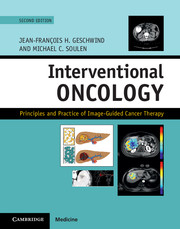Book contents
- Frontmatter
- Contents
- List of contributors
- Section I Principles of oncology
- Section II Principles of image-guided therapies
- 2 Principles of radiofrequency and microwave tumor ablation
- 3 Principles of irreversible electroporation
- 4 Principles of high-intensity focused ultrasound
- 5 Principles of tumor embolotherapy and chemoembolization
- 6 Principles of radioembolization
- 7 Principles of intra-arterial infusional chemotherapy in the treatment of liver metastases from colorectal cancer
- 8 Imaging in interventional oncology: Role of image guidance
- 9 Novel developments in MR assessment of treatment response after locoregional therapy
- Section III Organ-specific cancers – primary liver cancers
- Section IV Organ-specific cancers – liver metastases
- Section V Organ-specific cancers – extrahepatic biliary cancer
- Section VI Organ-specific cancers – renal cell carcinoma
- Section VII Organ-specific cancers – chest
- Section VIII Organ-specific cancers – musculoskeletal
- Section IX Organ-specific cancers – prostate
- Section X Specialized interventional techniques in cancer care
- Index
- References
9 - Novel developments in MR assessment of treatment response after locoregional therapy
from Section II - Principles of image-guided therapies
Published online by Cambridge University Press: 05 September 2016
- Frontmatter
- Contents
- List of contributors
- Section I Principles of oncology
- Section II Principles of image-guided therapies
- 2 Principles of radiofrequency and microwave tumor ablation
- 3 Principles of irreversible electroporation
- 4 Principles of high-intensity focused ultrasound
- 5 Principles of tumor embolotherapy and chemoembolization
- 6 Principles of radioembolization
- 7 Principles of intra-arterial infusional chemotherapy in the treatment of liver metastases from colorectal cancer
- 8 Imaging in interventional oncology: Role of image guidance
- 9 Novel developments in MR assessment of treatment response after locoregional therapy
- Section III Organ-specific cancers – primary liver cancers
- Section IV Organ-specific cancers – liver metastases
- Section V Organ-specific cancers – extrahepatic biliary cancer
- Section VI Organ-specific cancers – renal cell carcinoma
- Section VII Organ-specific cancers – chest
- Section VIII Organ-specific cancers – musculoskeletal
- Section IX Organ-specific cancers – prostate
- Section X Specialized interventional techniques in cancer care
- Index
- References
Summary
Introduction: Multiparametric MRI
Precise and early assessment of treatment response is critical after locoregional therapy. In patients with unresectable tumors, magnetic resonance imaging (MRI) represents an important tool for posttreatment follow-up. Its advantages include the absence of ionizing radiation and a sophisticated repertoire of anatomic, functional, and molecular imaging techniques. Multiparametric MRI combines several of these techniques in order to optimize tumor characterization and enable superior assessment of treatment response. The goal of multiparametric MRI is to permit elucidation of a “tumor-imaging phenotype” by maximally exploiting these techniques. The tumor-imaging phenotype may assist in predicting and assessing response to a variety of anticancer therapies. Posttreatment imaging parameters such as alterations in contrast enhancement and apparent diffusion coefficient (ADC) values may serve as treatment response biomarkers.
Widespread reliance on imaging biomarkers of treatment response demands a certain degree of scientific rigor. The ideal imaging biomarker must satisfy at least four criteria. First, it must permit early assessment of treatment response, allowing timely modification of treatment regimens and preventing unnecessary toxicity to patients. Second, it must enable reproducible quantifications of treatment response. This presupposes a clear appraisal of measurement error such that chance variation can be reliably distinguished from true response. Third, it must be capable of contending with tumor heterogeneity. Tumors represent intrinsically complex and heterogeneous ecosystems, a fact reflected in their treatment response. Variable degrees of posttreatment necrosis may be seen in a single tumor. Targeted retreatment of tumors depends on the imaging modality's ability to represent this variability with high fidelity. Fourth, it must be able to predict not only surrogate endpoints, but also survival. Surrogate endpoints include alterations in lesion characteristics over time, be these anatomic or functional. The optimal endpoint, however, is patient survival.
Cross-sectional assessment of treatment response has traditionally been based on anatomic imaging criteria. Stratification of patients into response categories has relied on changes in tumor size, with measurements obtained in the axial plane. The limitations of these anatomic criteria have encouraged the use of functional and molecular imaging biomarkers in the response assessment. The repertoire of functional MRI techniques includes: diffusion-weighted MRI (DW-MRI), dynamic and dual-phase contrast-enhanced MRI (DCE- and CE-MRI), MRI spectroscopy, and positron emission tomography (PET) MRI.
- Type
- Chapter
- Information
- Interventional OncologyPrinciples and Practice of Image-Guided Cancer Therapy, pp. 77 - 84Publisher: Cambridge University PressPrint publication year: 2016



